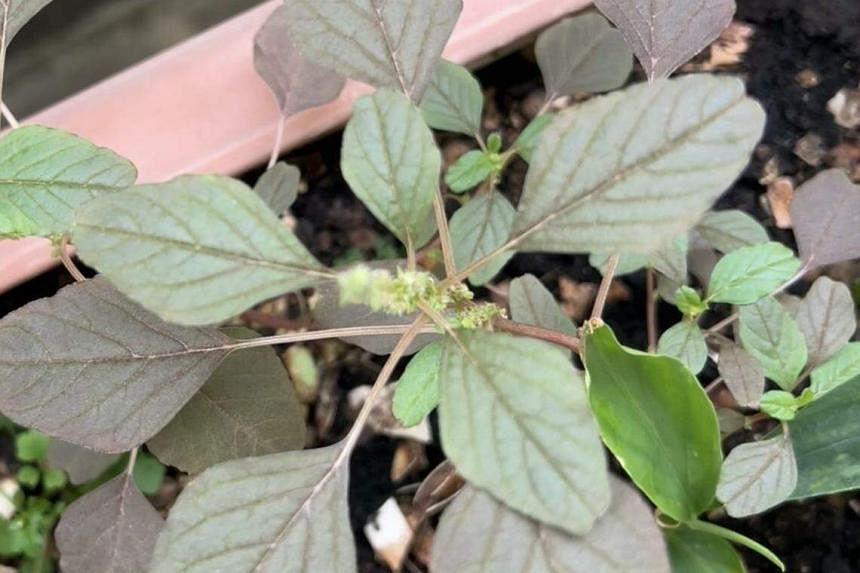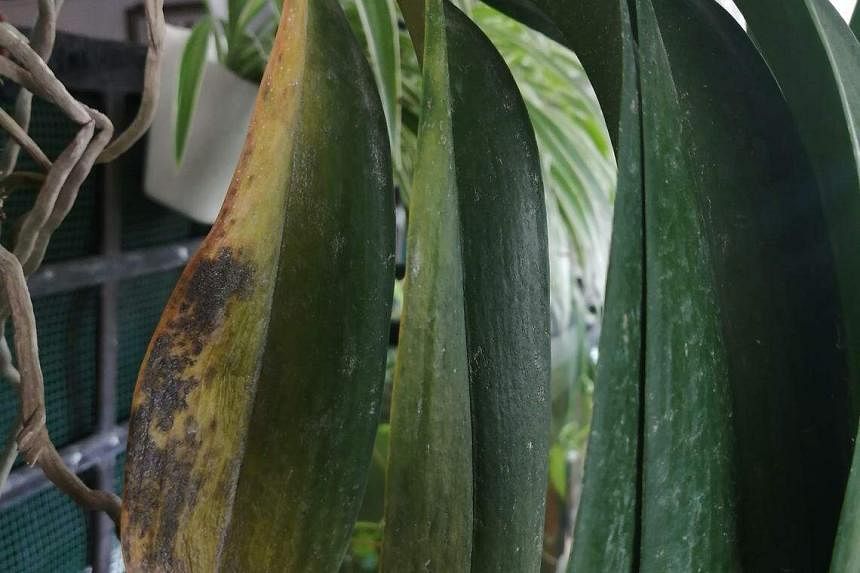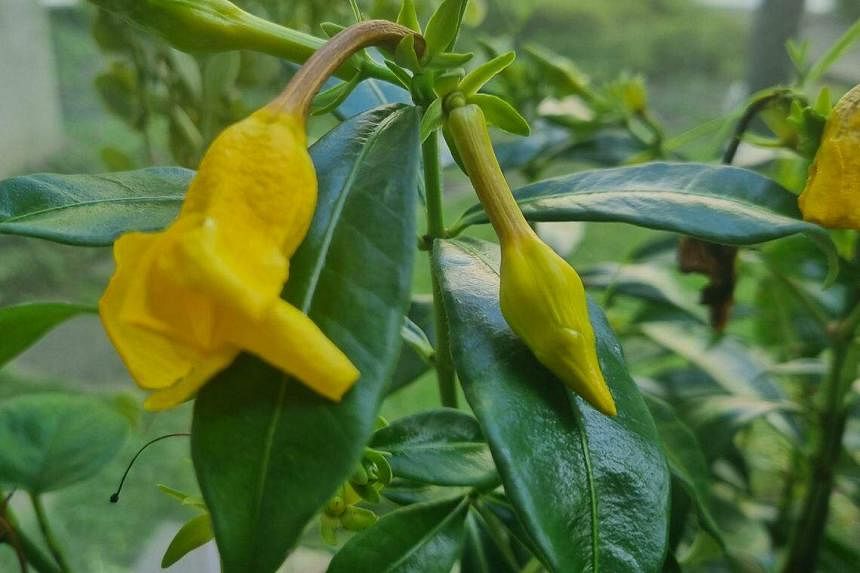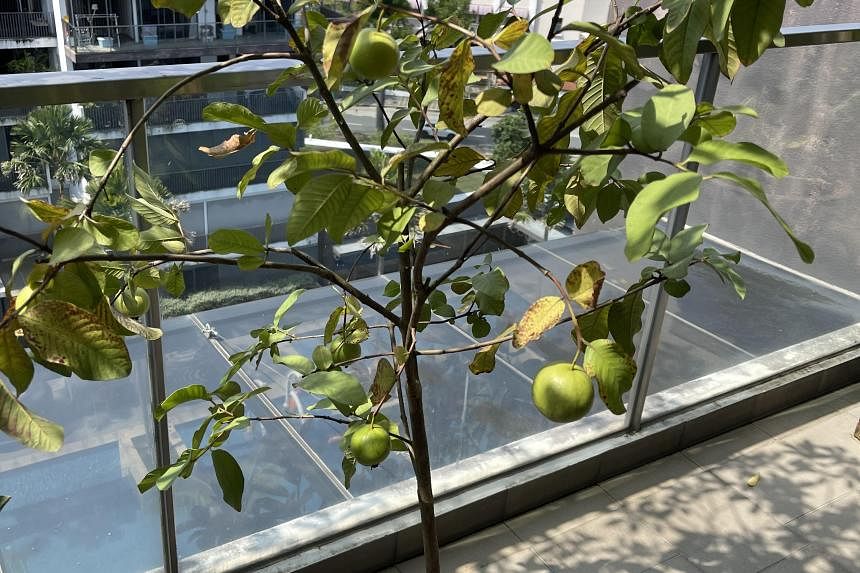Grow guava in a bigger pot
My guava plant’s fruit are small and the leaves are turning brown. What is wrong?
Tan Eng Lai
Your guava plant looks stressed. The yellowing leaves indicate that the plant is suffering from a lack of water, nutrients or both.
As the pot looks small, it is possible the guava plant has exhausted the nutrients within its growing mix due to the limited soil volume, which will also cause the plant to dry out quickly and wilt during hot weather. Try growing it in a bigger pot with fresh growing media.
Let the plant channel its limited resources into producing a few good fruit over numerous small ones that may be aborted when the plant is stressed. Retain a few fruit for them to develop fully and remove the remaining ones. During fruit development, ensure the plant gets ample water and nutrients.
Plant is a species of Amaranthus

What is this plant? It sprouted from a potting mix containing coffee grounds and eggshells.
Low Hock Leong
The plant is likely the Livid Amaranth (Amaranthus blitum) and its young leaves are edible. It is a plant that is related to common edible leafy vegetables such as the Chinese Spinach (Amaranthus tricolor). As it grows quickly and produces abundant seeds, new plants will regrow in the same bed and can become a nuisance that need to be removed on a regular basis.
High-rise apartment conditions may not be conducive to orchid’s growth

My Phalaenopsis orchids were growing well for the first few years in a Housing Board corridor without direct sunlight. I watered and sprayed the roots and leaves often as they dried out easily, but the plant did not flower. The leaves have also turned yellow lately and developed patches. How can I help my plant and get it to flower? What kind of orchid is easier to rear in our environment?
Dennis Chang
Your orchid’s shrivelled leaves indicate a lack of water. Note that high-rise apartment conditions are dry, so you may need to use moisture-retentive growing materials, such as sphagnum moss, around the roots, to slow the drying-out process.
You can also install a timer-controlled misting system that will increase the ambient humidity over the course of the day. This will also bring down the temperature of the environment. Fungicides such as Thiram, which is available in local nurseries, can be applied regularly to reduce the likelihood of disease.
Phalaenopsis orchids are commonly sold as potted plants for floriculture displays, but it can be difficult to get them to bloom again without cooling. They tend to stay vegetative under Singapore’s tropical climate, which is expected to get warmer in the years to come.
You can try Phalaenopsis cornu-cervi (Deer-antlered Phalaenopsis) and Phalaenopsis violacea, which are two species grown by local orchid hobbyists. Ensure you are able to provide suitable environmental conditions for their growth. Stressed plants grown under dry conditions can also be infested with spider mites.
Succulent needs direct sunlight to stay compact
What is this succulent and do you have any tips on caring for it? The first picture is of its compact form when I first got it.
Javier Chew
The plant is probably a cultivar of Echeveria or a species of the Crassulaceae family.
Your plant’s lanky growth, distance between leaves and loss of colouration are likely due to a lack of sunlight. In general, plants in this genus require direct sunlight for at least six hours a day to thrive and stay compact. This is not an indoor plant and it will not thrive in the shade.
Another reason for its current condition could be due to Singapore’s tropical weather. Many species and cultivars in this genus develop their intense colouration during winter when temperatures are low. Succulents in Singapore typically stay green and do not develop vivid colours due to the high temperatures here.
For now, you can cut the top part of the plant and root it in a pot of well-draining, gritty growing media. Once it has established itself, you can move it to a sunny spot that is protected from the rain. Excessive moisture can cause the plant to succumb to disease and rot.
Check Golden Trumpet’s root health

What plant is this? It was blooming when I bought it, but the buds began to fall off and the leaves drooped after a few weeks. Could it be due to the recent weeks of rain?
Pamelin Ho
Your Golden Trumpet (Allamanda cathartica) is often grown in Singapore as an outdoor plant. It thrives under direct sunlight and in well-draining growing media. It is not a shade-tolerant plant, so its current state may be due to a combination of shade and rainy weather.
Also, if the plant’s growing mix was kept moist throughout the rainy spell, the roots may be waterlogged or diseased. Under such conditions, the plant cannot take up water and its aerial parts may droop.
Check the roots – healthy ones should be white and firm, rather than black or brown and mushy. To salvage the plant, take stem cuttings and root them separately.
- Answers by Dr Wilson Wong, an NParks-certified practising horticulturist and parks manager. He is the founder of Green Culture Singapore and an adjunct assistant professor (Food Science & Technology) at the National University of Singapore.
- Have a gardening query? E-mail it with clear, high-resolution pictures of at least 1MB, if any, and your full name to stlife@sph.com.sg. We reserve the right to edit and reject questions.

